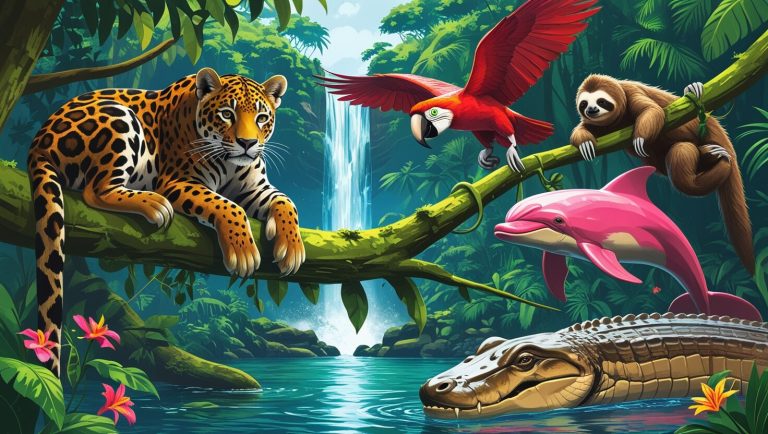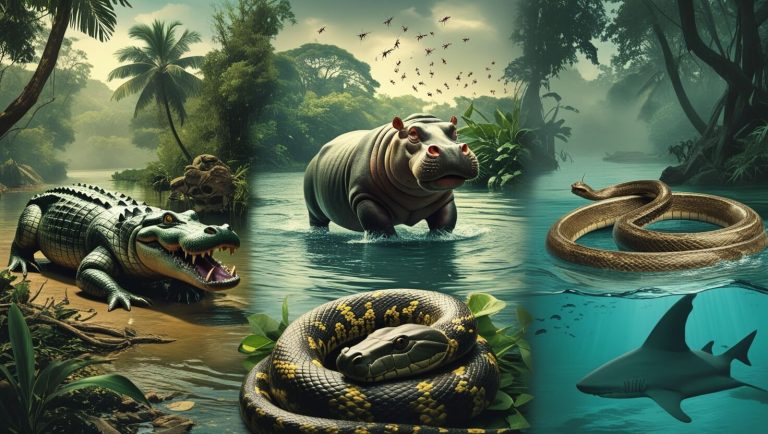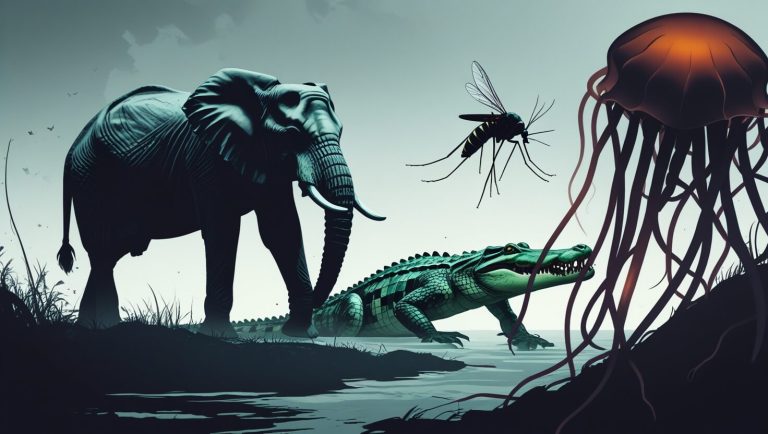Top 10 Animals in the World
Did you know there’s an animal that can regrow its entire body from just a tiny fragment? Or one that’s so small it can survive extreme conditions that would obliterate any human? The world is full of incredible creatures, each with unique traits that make them captivating to animal lovers everywhere.
Animals fascinate us, not just because of their diversity and beauty but because they offer astonishing insights into evolution and survival. From powerful apex predators to quirky underdogs of the natural world, there’s something extraordinary about every species. Today, we’re counting down the top 10 most fascinating animals on Earth, showcasing a mix of well-loved icons and some surprising wildcards.
Get ready to be amazed. Do any of your favorites make the list?

How We Chose the Top 10
Before we get into the list, here’s a look at how these animals were selected. The creatures featured in this post stand out for one (or more) of the following reasons:
- Unique Features: Physical traits that are mind-blowing or entirely one-of-a-kind.
- Behavioral Quirks: Unbelievable abilities or fascinating habits.
- Ecological Importance: Their role in maintaining ecosystems.
- Human Connection: Their influence on culture or symbolism.
Of course, any list like this is subjective, so if you have a favorite animal that didn’t make the cut, we’d love to hear about it in the comments! Now, on to the countdown.
Top 10 Animals in The World
10: Axolotl
- Habitat: Lakes in Mexico
- Why It’s Fascinating: Dubbed the “Mexican walking fish,” the axolotl can regenerate entire limbs, spinal cords, and even parts of its heart or brain!
- Fun Fact: Unlike most amphibians, axolotls never undergo full metamorphosis, meaning they remain in their juvenile form for life.
- Why It Matters: Axolotls are important in scientific research for studying regeneration and genetic diseases.
Meet the axolotl, a quirky little salamander from Mexico’s murky waters. This guy looks like a Pokémon with its frilly gills and permanent grin, but what’s truly wild is its superpower: regeneration. Chop off a leg? It grows back. Heart damaged?
No problem—it’ll fix that too. Scientists are obsessed with this aquatic oddball because it could unlock secrets to healing in humans. Fun fact: Axolotls stay “young” forever, never fully maturing into land-dwellers like other amphibians.
Sadly, they’re critically endangered due to habitat loss. They matter because they’re a living lesson in resilience—and a reminder of what we could lose if we’re not careful.
9: Giant Panda
- Habitat: Mountain forests in China
- Why It’s Fascinating: Pandas subsist almost entirely on bamboo, consuming up to 40 pounds daily.
- Fun Fact: Despite their bear classification, pandas don’t hibernate.
- Why It Matters: Longstanding conservation efforts for pandas symbolize the global fight to protect endangered species.
Who doesn’t love a panda? With their black-and-white fluff and bamboo-munching charm, giant pandas are nature’s teddy bears. Native to China’s misty mountains, they’ve become global symbols of conservation.
What’s fascinating? They’re carnivores by design—bear family, sharp teeth—but 99% of their diet is bamboo, which they chew for hours daily. Fun fact: A panda’s “thumb” is actually a modified wrist bone, perfect for gripping stalks.
They’ve climbed back from the brink of extinction, thanks to human efforts. Pandas remind us that even the cuddliest creatures can teach us about survival and adaptability in a changing world.
8: Blue Whale
- Habitat: Oceans worldwide
- Why It’s Fascinating: The Blue Whale is the largest animal to have ever existed, growing up to 100 feet long and weighing 200 tons.
- Fun Fact: Its heart alone weighs around 400 pounds, about the same as a small piano!
- Why It Matters: Playing a crucial role in marine ecosystems, their conservation is vital to ocean health and biodiversity.
The blue whale is the heavyweight champ of Earth—bigger than any dinosaur, stretching up to 100 feet and weighing as much as 200 tons. Found in oceans worldwide, its heart alone is car-sized, and its tongue could hold 50 people.
What’s mind-blowing? It survives on tiny krill, gulping millions daily through baleen plates. Fun fact: Its calls are louder than a jet engine, yet too low for human ears to catch. Blue whales matter because they’re living giants, balancing marine ecosystems by cycling nutrients. They’re a testament to nature’s ability to scale up in ways we can barely fathom.
7: Bald Eagle
- Habitat: North America
- Why It’s Fascinating: This iconic bird represents strength and freedom and has some of the sharpest eyesight of any predator.
- Fun Fact: Bald eagles can see four to seven times farther than humans, spotting fish from up to two miles away!
- Why It Matters: Once on the brink of extinction in the 1960s, conservation efforts have brought this majestic bird back as a success story for endangered species.
Soaring over North America, the bald eagle is a feathered icon of freedom. With a snowy head and piercing gaze, it’s a hunter extraordinaire, snatching fish mid-flight with talons like grappling hooks. What’s fascinating? Its comeback story—nearly wiped out by pesticides, it’s now thriving thanks to conservation.
Fun fact: Eagles mate for life, performing dazzling aerial dances to bond. They matter because they’re symbols of resilience, proving nature can rebound with a little help. Watching one glide over a lake feels like witnessing history in motion—a predator that’s earned its perch in the wild and our imaginations.
6: Octopus
- Habitat: Oceans worldwide
- Why It’s Fascinating: These masters of camouflage can change their color and texture to blend seamlessly into surroundings.
- Fun Fact: An octopus has three hearts and blue blood!
- Why It Matters: Their intelligence challenges our understanding of animal cognition, offering fascinating insights into evolution.
The octopus is the ocean’s resident genius. With eight arms, three hearts, and a brain that rivals some mammals, this cephalopod is a master of disguise, shifting colors to vanish into coral or sand. What’s wild? It can solve puzzles, use tools, and even escape aquariums—true Houdinis of the deep.
Fun fact: If cornered, it blasts ink to confuse predators. Octopuses matter because they challenge our ideas of intelligence—proof it doesn’t need a backbone to be brilliant. They’re elusive, mysterious, and a reminder that the sea holds secrets we’re still unraveling.
5: Cheetah
- Habitat: Grasslands in Africa
- Why It’s Fascinating: The fastest land animal, cheetahs can accelerate from 0 to 60 mph in just three seconds.
- Fun Fact: Their unique black “tear marks” help reduce sun glare while hunting.
- Why It Matters: Cheetahs highlight the delicate balance between survival and conservation in fast-changing ecosystems.
Blink, and you’ll miss it—the cheetah is the fastest land animal, hitting 60 mph in seconds. Stalking Africa’s plains, its slender frame and spotted coat are built for speed, with claws that grip like cleats. What’s fascinating? It’s a sprinter, not a marathoner, exhausting itself in short bursts to nab prey.
Fun fact: Its tear-like facial marks might help with glare, like a natural sunblock. Cheetahs matter because they embody raw power and precision, but they’re vulnerable—habitat loss threatens their run. They’re a high-speed marvel, showing how evolution fine-tunes for survival.
4: Elephant
- Habitat: Grasslands and forests in Africa and Asia
- Why It’s Fascinating: Known for their memory and intelligence, elephants display complex emotions and strong social bonds.
- Fun Fact: Elephants can communicate across miles using low-frequency rumbles.
- Why It Matters: These gentle giants shape their landscapes, making them keystone species for their habitats.
Elephants are gentle giants with brains to match. Roaming Africa and Asia, they’re the largest land animals, wielding trunks that can hug, dig, or trumpet warnings. What’s incredible? Their memory—matriarchs lead herds across vast distances, recalling water holes from decades past. Fun fact: They mourn their dead, showing emotion we once thought was uniquely human.
Elephants matter because they shape ecosystems, clearing paths and spreading seeds. They’re symbols of strength and wisdom, yet poaching puts them at risk. These pachyderms prove size isn’t everything—it’s the depth of their bonds that leaves a mark.
3: Great White Shark
- Habitat: Coastal waters worldwide
- Why It’s Fascinating: This apex predator senses electrical signals emitted by other creatures, even detecting a heartbeat from miles away.
- Fun Fact: Great whites can go months without eating after a large meal.
- Why It Matters: Sharks are vital to maintaining healthy oceanic ecosystems as a top predator.
The great white shark is the ocean’s apex predator, a sleek torpedo of teeth and instinct. Patrolling coasts worldwide, its serrated jaws can crush bone, yet it’s not the mindless killer of movies. What’s fascinating? It’s warm-blooded, rare for fish, letting it chase prey in cold waters. Fun fact: Sharks smell blood a mile away, but they’d rather eat seals than humans.
They matter because they keep marine food webs in check—without them, ecosystems wobble. Great whites are raw power wrapped in mystery, proving nature’s balance hinges on its fiercest players.
2: Polar Bear
- Habitat: Arctic regions
- Why It’s Fascinating: Designed for extreme cold, polar bears have black skin under their translucent fur to absorb sunlight effectively.
- Fun Fact: They are fantastic swimmers, capable of swimming over 60 miles without resting.
- Why It Matters: Polar bears are emblematic of the impacts of climate change, serving as a reminder to protect fragile ecosystems.
The polar bear reigns over the Arctic, a white titan built for ice and snow. With paws like snowshoes and a nose that sniffs seals from miles off, it’s a master of its frozen world. What’s incredible? It swims hundreds of miles, fueled by a thick blubber layer.
Fun fact: That “white” fur? It’s clear, reflecting light to blend in. Polar bears matter because they’re sentinels of climate change—melting ice threatens their hunt. They’re survivalists in a harsh realm, showing us beauty and grit in equal measure, and why we must protect their icy home.
1: Tardigrade
- Habitat: Practically anywhere—from deep oceans to outer space!
- Why It’s Fascinating: These microscopic creatures, also called water bears, can survive extreme heat, the vacuum of space, and even radiation.
- Fun Fact: Tardigrades can go years without water, essentially pausing their metabolism in a state called cryptobiosis.
- Why It Matters: Their resilience inspires scientific research in fields like medicine and space exploration.
Surprise! Topping our list is the microscopic tardigrade, aka the water bear. Barely visible, this tiny titan thrives everywhere—mountains, oceans, even space. What’s unreal? It survives radiation, freezing, boiling, and dehydration by curling into a “tun” state, reviving when conditions improve. Fun fact: It’s endured all five mass extinctions, laughing off apocalypses for 500 million years.
Tardigrades matter because they’re the ultimate survivors, showing life can cling on in the harshest corners. They’re not flashy, but their resilience beats every giant on this list. Nature’s toughest critter isn’t a roaring beast—it’s a speck that redefines what “fascinating” can mean. Move over, lions—this is the real king of the wild!
Honorable Mentions
While they didn’t make the top 10, these animals deserve a quick shoutout:
- Hummingbird (incredible hovering capabilities).
- Komodo Dragon (world’s largest lizard and venomous predator).
- Platypus (a mammal that lays eggs and has a venomous spur).
Couldn’t fit everyone! The Komodo dragon nearly bit its way in with its venomous chomp, but it’s too niche. Hummingbirds dazzled us with their hover-speed (80 wingbeats a second!), yet missed the cut.
And the platypus—egg-laying mammal with a duck bill? Almost, but its weirdness felt too specific. These runners-up deserve a nod for their own wild quirks. Nature’s roster is deep, and narrowing it to 10 was tough. Who’d you add? Drop your picks below—we’re all ears!
Why These Animals Matter
This list isn’t just a parade of cool critters—it’s a snapshot of Earth’s diversity. Axolotls hint at medical breakthroughs; pandas show conservation can work. Blue whales and sharks balance oceans, while cheetahs and eagles highlight speed and skill.
Elephants shape landscapes, polar bears warn of warming, and tardigrades prove life’s tenacity. Each one reflects evolution’s creativity, from microscopic toughness to massive majesty. They matter because they’re threads in nature’s web—pull one, and the whole thing frays.
Plus, they spark our curiosity, urging us to explore, protect, and marvel. Want to dig deeper? Check local wildlife groups or documentaries—natures got more stories than we can count.
Questions and Answers (Q&A)
u003cstrongu003eWhich animal is the smartest?u003c/strongu003e
This is a tricky question because animals are smart in different ways. For problem-solving and tool use, chimpanzees and octopuses are very smart. For understanding human language, the African Grey Parrot is a genius. For social intelligence and communication, dolphins and elephants are at the top. So, there isn’t just one u0022smartestu0022 animal!
u003cstrongu003eWhy are so many amazing animals endangered?u003c/strongu003e
The main reasons are habitat loss (where forests are cut down for farms or cities), pollution (dirtying the air and water), climate change (changing weather patterns), and poaching (illegal hunting). When an animal’s home is destroyed or it is hunted too much, its population drops until it becomes endangered.
u003cstrongu003eWhat is the difference between a poisonous animal and a venomous one?u003c/strongu003e
This is a common mix-up! If you bite it and you get sick, it’s u003cstrongu003epoisonousu003c/strongu003e. If it bites you and you get sick, it’s u003cstrongu003evenomousu003c/strongu003e. For example, a poison dart frog is poisonous because its skin has toxins. A rattlesnake is venomous because it injects venom through its fangs.
u003cstrongu003eHow can I help with wildlife conservation?u003c/strongu003e
There are many easy ways to help! You can learn about and support zoos and organizations that protect animals. You can make your garden friendly for bees and butterflies by planting native flowers. Reducing, reusing, and recycling helps reduce pollution and habitat destruction. Every small action helps.
u003cstrongu003eDo animals have feelings like humans do?u003c/strongu003e
While we can’t know exactly what an animal feels, science shows that many animals experience emotions. Elephants clearly show grief. Dogs show joy and excitement. Whales and primates show strong family bonds. It’s safe to say that many animals have rich emotional lives, even if they are different from our own.
Conclusion
There you have it—our top 10, from regenerating salamanders to invincible water bears. These animals dazzle, inspire, and sometimes humble us with their brilliance. Whether it’s the cheetah’s blur, the octopus’s smarts, or the tardigrade’s grit, they’re all stars in Earth’s epic tale.
What’s your favorite? Vote in the comments or share this with a fellow animal lover. Better yet, step outside—nature’s waiting to wow you in person. The animal kingdom’s a wild, wonderful place, and these 10 are just the beginning. Here’s to the creatures that make our planet extraordinary—long may they roam, swim, and scuttle.
judi bola

Rony Junior is a lifelong animal lover who’s happiest with muddy paws on the couch and fur on their clothes. From curious cats to loyal dogs and everything in between, they write about the joy, challenges, and quirks of living alongside animals. When not blogging, you can find them at the local shelter, giving belly rubs and making new four-legged friends.







